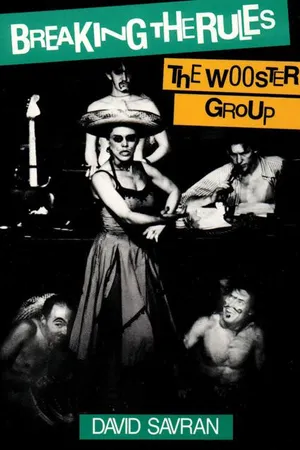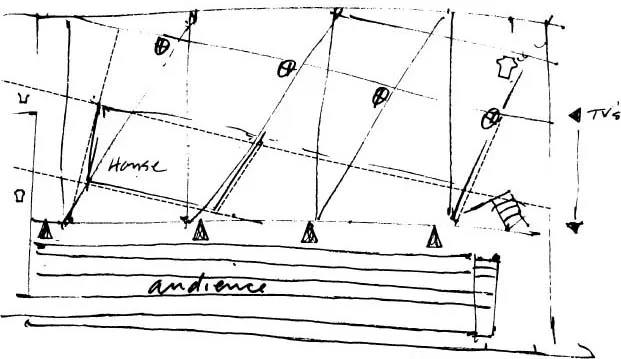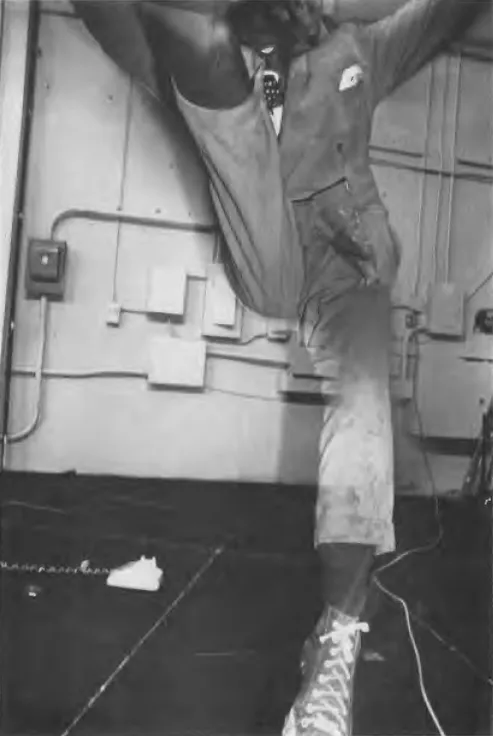
eBook - ePub
Breaking the Rules
The Wooster Group
David Savran
This is a test
Buch teilen
- 240 Seiten
- English
- ePUB (handyfreundlich)
- Über iOS und Android verfügbar
eBook - ePub
Breaking the Rules
The Wooster Group
David Savran
Angaben zum Buch
Buchvorschau
Inhaltsverzeichnis
Quellenangaben
Über dieses Buch
Through interviews and descriptions of methodology, Breaking the Rules captures the essence of major works by the internationally acclaimed avant-garde company.
Häufig gestellte Fragen
Wie kann ich mein Abo kündigen?
Gehe einfach zum Kontobereich in den Einstellungen und klicke auf „Abo kündigen“ – ganz einfach. Nachdem du gekündigt hast, bleibt deine Mitgliedschaft für den verbleibenden Abozeitraum, den du bereits bezahlt hast, aktiv. Mehr Informationen hier.
(Wie) Kann ich Bücher herunterladen?
Derzeit stehen all unsere auf Mobilgeräte reagierenden ePub-Bücher zum Download über die App zur Verfügung. Die meisten unserer PDFs stehen ebenfalls zum Download bereit; wir arbeiten daran, auch die übrigen PDFs zum Download anzubieten, bei denen dies aktuell noch nicht möglich ist. Weitere Informationen hier.
Welcher Unterschied besteht bei den Preisen zwischen den Aboplänen?
Mit beiden Aboplänen erhältst du vollen Zugang zur Bibliothek und allen Funktionen von Perlego. Die einzigen Unterschiede bestehen im Preis und dem Abozeitraum: Mit dem Jahresabo sparst du auf 12 Monate gerechnet im Vergleich zum Monatsabo rund 30 %.
Was ist Perlego?
Wir sind ein Online-Abodienst für Lehrbücher, bei dem du für weniger als den Preis eines einzelnen Buches pro Monat Zugang zu einer ganzen Online-Bibliothek erhältst. Mit über 1 Million Büchern zu über 1.000 verschiedenen Themen haben wir bestimmt alles, was du brauchst! Weitere Informationen hier.
Unterstützt Perlego Text-zu-Sprache?
Achte auf das Symbol zum Vorlesen in deinem nächsten Buch, um zu sehen, ob du es dir auch anhören kannst. Bei diesem Tool wird dir Text laut vorgelesen, wobei der Text beim Vorlesen auch grafisch hervorgehoben wird. Du kannst das Vorlesen jederzeit anhalten, beschleunigen und verlangsamen. Weitere Informationen hier.
Ist Breaking the Rules als Online-PDF/ePub verfügbar?
Ja, du hast Zugang zu Breaking the Rules von David Savran im PDF- und/oder ePub-Format sowie zu anderen beliebten Büchern aus Medios de comunicación y artes escénicas & Arte y escenografía teatral. Aus unserem Katalog stehen dir über 1 Million Bücher zur Verfügung.
Information
Part I
Route 1 & 9 (The Last Act): The Disintegration of Our Town
Our Town:
(no inflection) “Your mother’ll be coming downstairs to make believe, uh, make breakfast.”
“Chew that bacon good and slow. It’ll help keep you warm on a cold day.”
“. . . his appendix burst on a hunting trip in North Conway.”
“There are the stars making the crisscross . . .”
“This is the worst piece of shit.” “Shut up, I like it, it reminds me of Carousel.”
(Lizzie: incredible innocence & the hokey philosopher profound dimensions in downhome and he’s an asshole)
Nayatt School Notebook October 11, 1977
Elizabeth LeCompte: We began doing Our Town as a reading, fitting people into parts, rehearsing it during the day and performing it at night. Just as a reading, but excluding the part of the Stage Manager, that voice that connects, so that it would stand as a number of scenes, placed next to each other.
Kate Valk: When we started working on Route 1 & 9, it was just Our Town, reading Our Town, and I was still stage managing. Then I transcribed the Pigmeat Markham records, trying to figure out what they were saying. By the time I finished I could imitate . . . I could do all the voices. And that’s how I got started performing in Route 1 & 9, with the blackface routines.
Peyton Smith: The beginning of rehearsals was wonderful because the live performance part was dancing. And many of the early rehearsals, before we got into any depth, were spent making this wonderful musical piece that was a lot of fun to do. Of course, then it became more problematic, when we started realizing the intent, and how far it went.
***
When Route 1 & 9 (The Last Act) opened at the Performing Garage in October 1981, it polarized its audience more radically than any piece performed in New York in at least a decade. By January 1982 it had become the subject of a widely reported controversy. The dispute centered around the piece’s juxtaposition of Thornton Wilder’s Our Town against a reconstruction of a Pigmeat Markham comedy routine, performed by four actors in blackface. The New York State Council on the Arts (NYSCA), which has been a major source of funding for the Group, judged that “Route 1 & 9 contained in its blackface sequences harsh and caricatured portrayals of a racial minority”1 and, as a consequence, cut funding for the Group by forty percent, the fraction of the grant they believed subsidized the piece. The Wooster Group convened a number of public forums to discuss the piece’s alleged racism and in March submitted an appeal to NYSCA, drawn up by Jeffrey M. Jones, aimed at restoring the funding. The appeal contained a thirty-one-page defense of Route 1 & 9 as well as twenty-three letters of support by a formidable collection of artists, critics and producers. On June 10, 1982, NYSCA rejected the appeal and upheld the reduced level of funding.
***
Schema of Route 1 & 9 (The Last Act)
| Part IA | THE LESSON (Upstairs): In Which A Man Delivers a Lecture on the Structure and Meaning of Our Town |
Video reconstruction of “teaching film” | |
| Part IB | THE LESSON (Downstairs): In Which the Stage Hands Arrange the Stage for the Last Act of Our Town |
“The Lesson” continues Blind building sequence begins Black out | |
| Part II | THE PARTY: In Which the Stage Hands Call It a Day and a Telegram Is Sent |
Blind building continues The “girls” make telephone calls The Party begins (reconstruction of Pigmeat Markham routine) Video excerpts from Our Town, Act II, overlap | |
| Part III | THE LAST ACT (The Cemetery Scene): In Which Four Chairs are Placed on the Stage Facing the Audience to Represent Graves |
Video excerpts from Our Town, Act III, begin The Party continues “sotto voce” Ghoul Dance | |
| Part IV | ROUTE 1 & 9: In Which a Van Picks Up Two Hitchhikers and Heads South |
Video: “Route 1 & 9” (Driving sequence) Porn |
***

Figure 1.Performance Space for Route 1 & 9 (The Last Act)
(Elizabeth LeCompte)
(Elizabeth LeCompte)
Elizabeth LeCompte: In the beginning I had an image of the performers in blackface. Wonderful visual thing. I thought of the blackface on them, and the lighting. And I could see, almost immediately, a kind of dance structure, going up and back, along an expanded floor grid from Point Judith. Usually, that’s one of the very first things that comes: a spatial element from the preceding piece, something I couldn’t do there, that pushed it too far, or that didn’t work, in some way. It’s as if each space is an interpolation of the last. Or a rearrangement of the last, or the space before that. The performance space had been falling more and more into a kind of parallelogram grid. I took the pattern of the house drawn on the floor from the earlier pieces, the parallelogram that it had become, and extended it over the whole space. The tin house would stand on top of the grid. And we constructed dances around that. Like on a chalk board. I knew that the audience would look down from above, onto a blackboard, that I was going to be sketching on a blackboard, so to speak. And the characters would be dancing and sketching in white on a black board.

Figure 2.Route 1 & 9, The Party
Willem Dafoe, Ron Vawter.
(Nancy Campbell)
Willem Dafoe, Ron Vawter.
(Nancy Campbell)

Ron Vawter: I knew very well that we were unsettling people’s feelings, and our own feelings, about racism: racism in ourselves, racism in everybody in the audience, black and white. And it was all about pulling the rug out from under people’s secure, liberal and righteous feelings about racism, their own and society’s. We were agents provocateurs, saboteurs, working against people’s strong feelings of righteousness.
Peyton Smith: Well, sometimes, we got really scared when things got bad. I remember this one night . . . in the beginning when we got bad reviews, we’d have maybe seven people in the audience. And Route 1 & 9 is a hard show to do for seven people. Anyway, there weren’t too many people this one night. And I went through such a horror. There was a black man in the audience. And he had his coat over his lap. And he would put his hand under his coat. We were doing the part way up front, about the punch and I thought, “He’s going to shoot us. He’s closest to Ronnie. Well, I love Ronnie but that’s the way it goes. I’m going to dive under the seating arrangement.” And I had it all blocked out in my mind. And then, of course, nothing happened. So when we went off stage, I said, “Oh my God, I had such a fear.” And everyone else saw him. So it wasn’t that I was paranoid. It was so odd that we all picked up on it, because he never did anything. He just sat there, but he had this weird look. With Route 1 & 9, all the performances were exciting. And I liked that. I liked the controversy. But sometimes it was frightening.
***
Beyond Parody (Part I)
Elizabeth LeCompte: We reconstructed a 1965 Encyclopedia Britannica teaching film starring Clifton Fadiman. For a long time, I didn’t know where it would be played, we tried many different places. Finally, I separated it out and put it at the beginning, dovetailing it into the rest of the piece. Clifton Fadiman was the “Stage Manager” of Route 1 & 9, echoing Wilder s construction in Our Town. Then you’d see Ron come back as the Stage Manager, as Clifton Fadiman had played him in the tape. Those kinds of connectors came in late.
The first part of Route 1 & 9, “The Lesson: In Which a Man Delivers a Lecture,” is a videotaped lecture on Thornton Wilder’s Our Town, delivered by Ron Vawter and screened in the upstairs space at the Performing Garage. In the Wooster Group’s version, “The Lesson” appears to be a gentle mockery of the banalities of humanistic criticism. For the duration of the tape, the camera holds long static shots of the lecturer and pans portentously as he moves back and forth between a tiny model stage and the ladder to be used in Our Town (and Route 1 & 9). It zooms in for important “truths” and underscores them by spelling out the catch phrases across the bottom of the television screen. These production devices, combined with jump cuts in the editing (most of which were present in the print from which the Wooster Group worked), suggest that a subtly critical point of view is being taken toward both the speaker and his analysis of Our Town. In Ron Vawter’s deadpan characterization, the lecturer mouths the formulas of humanistic criticism with a forced informality and playfulness that mask his authoritarian pose. He explicates the play by setting himself up as a privileged interpreter who speaks for the audience: “He [Dr. Gibbs] uses the word unconsciously, he doesn’t notice it, but we do.”2 By so articulating the spectators’ emotions (“We’ve all had that feeling”3) he establishes his community with the audience in much the same way that Wilder implicates the spectator as a citizen of Our Town.
Ron Vawter: Fadiman makes these very unwieldly and awkward illustrative gestures. Willem and I studied them very carefully, second by second. When I look at my eyes in the tape, I’m amazed at how glazed over they look. I had done unconscious listening, putting on the audio tape when I was asleep. It’s as if performing it reinduced the sleep state I was in while I was digesting it.
The apparently ironic stance of “The Lesson” suggests a critique of the universalizing tendencies and the staunchly philosophical (rather than political) pose of liberal humanism. The lecturer, in what LeCompte calls his “extremely white analysis”4 of the play, would like the spectators to believe that Our Town is first and foremost a shared spiritual experience. Adopting the first person plural pronoun, he explains that the play assures the recognition that “all our lives are part of something vast and eternal.” He asserts that it “reconciles us to life” and “helps us to understand and so accept our existence on earth.” For him, Our Town, like “the humanities in general,” propounds an unchanging set of universal characteristics and all those things that “never go out of style”—birth, growing up, marriage and death.5 Between 8:40 and 11:00, the time the lecturer allots for a performance of Our Town, the Wooster Group reverses these axioms by historicizing the theatrical experience. It lifts the veil of aestheticism that certain artists and critics use to try to shield art from the realities of history and remove it from its po...